plant with unusual name has no less unusual properties. It is used not only for food, the fruits are removed in parts, and they themselves have bizarre shapes. Not every gardener takes up the cultivation of lagenaria, and not everyone knows what it is. But the results of the work are always amazing.
Lagenaria: description of culture
Many people know lagenaria under other names: Vietnamese zucchini, Indian cucumber, calabash, gourd, bottle gourd and others. Some researchers believe that she came from India to Vietnam, and from there in 1071 to Europe. The vegetable is a direct relative of squash, zucchini, pumpkin. But, unlike them, it is not grown as a creeping plant. To get a good harvest, you need a trellis of more than two meters, since the fruits can reach a length of one and a half meters. In addition, the plant itself is decorative, so it is often planted in those places in the garden or vegetable garden where you want to decorate vertical structures. Sometimes lagenaria is grown on balconies or loggias, as its agricultural technology is quite simple. 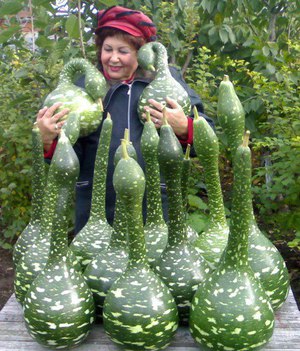 Did you know? The fruits of the plant were used to make various dishes even by the ancient Romans. Today, in addition to dishes, toys, musical instruments, smoking pipes, vases, and ashtrays are made from them in Latin America, Asia, and Africa. From long stems weave other things necessary in everyday life.
The vegetable resembles a zucchini in color, and in shape it can be the most diverse: in the form of a capsule, a bottle, a jug, serpentine and simply elongated, like a huge two-meter cucumber. The weight of such fruits varies from 3 to 7 kg. Only unripe fruits that have grown no more than 60 cm in length can be eaten. The same dishes are prepared from them as from pumpkin. For example, they cook caviar, salads, pancakes. Small fruits are stuffed, and very small ones are even pickled and salted. Ripe fruits are suitable only for the manufacture of various household items. It is not for nothing that the plant is also called the gourd. In vessels made from it, water does not heat up for a long time, and milk rarely sours.
Did you know? The fruits of the plant were used to make various dishes even by the ancient Romans. Today, in addition to dishes, toys, musical instruments, smoking pipes, vases, and ashtrays are made from them in Latin America, Asia, and Africa. From long stems weave other things necessary in everyday life.
The vegetable resembles a zucchini in color, and in shape it can be the most diverse: in the form of a capsule, a bottle, a jug, serpentine and simply elongated, like a huge two-meter cucumber. The weight of such fruits varies from 3 to 7 kg. Only unripe fruits that have grown no more than 60 cm in length can be eaten. The same dishes are prepared from them as from pumpkin. For example, they cook caviar, salads, pancakes. Small fruits are stuffed, and very small ones are even pickled and salted. Ripe fruits are suitable only for the manufacture of various household items. It is not for nothing that the plant is also called the gourd. In vessels made from it, water does not heat up for a long time, and milk rarely sours.
Features of growing lagenaria, choosing a place for planting
Often, lagenaria select such a place for planting so that it can delight not only with fruits, but with all its green mass. She braids arbors, fences, trees as an ornamental plant. At the same time, it requires minimal maintenance.
Heat and light for lagenaria
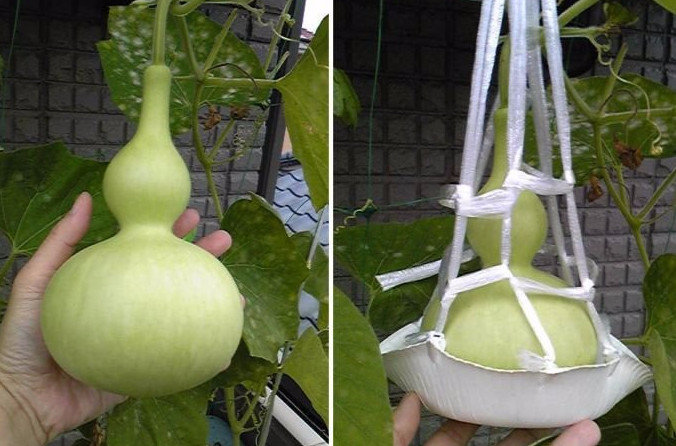 Just like ordinary cucumber or pumpkin, gourd gourd loves warmth and lots of light. At temperatures below 15 ° C, its seeds do not germinate, and young shoots in the shade develop very poorly. An adult plant can do well in the shade of a tree, using its trunk as a support. Therefore, it is best to choose open, lit areas for growing crops, where there will be a maximum amount of heat in summer. But at the same time they must be protected from wind and drafts. The ideal place for lagenaria is the sunny side of trees, fences, arbors, walls of houses.
Did you know? The vegetable has not only a high yield, but also a fantastic growth rate. Just a couple of weeks after the ovary, the fruit reaches one and a half meters in length.
Alternatively, you can place lagenaria in a greenhouse or greenhouse. In this case, you are guaranteed to get the expected yield. The greenhouse must be at least two meters high and have vertical trellises inside, along which the plant will curl.
Just like ordinary cucumber or pumpkin, gourd gourd loves warmth and lots of light. At temperatures below 15 ° C, its seeds do not germinate, and young shoots in the shade develop very poorly. An adult plant can do well in the shade of a tree, using its trunk as a support. Therefore, it is best to choose open, lit areas for growing crops, where there will be a maximum amount of heat in summer. But at the same time they must be protected from wind and drafts. The ideal place for lagenaria is the sunny side of trees, fences, arbors, walls of houses.
Did you know? The vegetable has not only a high yield, but also a fantastic growth rate. Just a couple of weeks after the ovary, the fruit reaches one and a half meters in length.
Alternatively, you can place lagenaria in a greenhouse or greenhouse. In this case, you are guaranteed to get the expected yield. The greenhouse must be at least two meters high and have vertical trellises inside, along which the plant will curl.
What kind of soil does lagenaria like
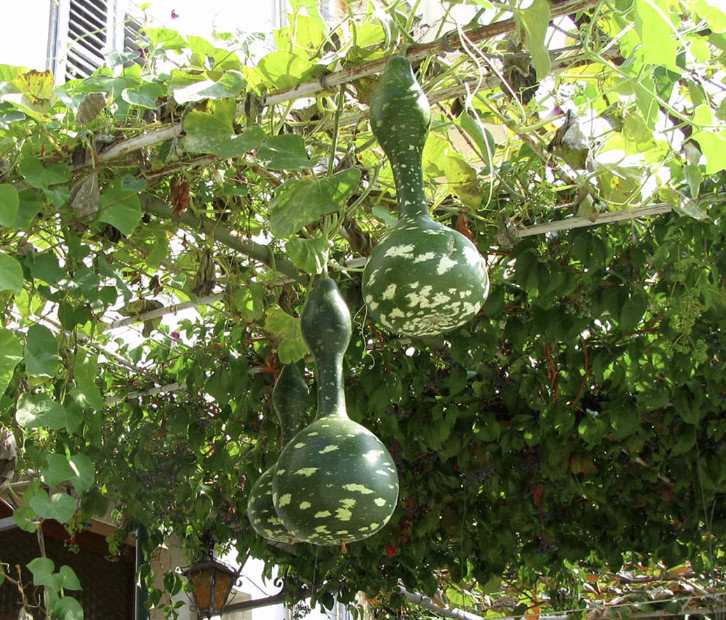 Lagenaria or, as it is also called, bottle gourd requires fertile soil with good drainage properties and low acidity. To do this, a layer of expanded clay or broken brick 3 cm high is laid out on the garden bed and sprinkled with soil, or it is necessary to dig up the soil with sand.
Lagenaria or, as it is also called, bottle gourd requires fertile soil with good drainage properties and low acidity. To do this, a layer of expanded clay or broken brick 3 cm high is laid out on the garden bed and sprinkled with soil, or it is necessary to dig up the soil with sand.
Since autumn, it is recommended to saturate the soil with the necessary fertilizers. In autumn, a biomass of leaves, bark, sawdust, tops is laid out at the proposed landing site and sprinkled with lime on top. After wintering in the spring, this mass is covered with manure with sawdust, in which seedlings can be planted.
How to grow lagenaria from seeds
Lagenaria reproduces only through seedlings, the cultivation of planting material from seeds begins in mid-April, although there are recommendations to do this a month before the planned planting in open ground.
How to prepare planting material
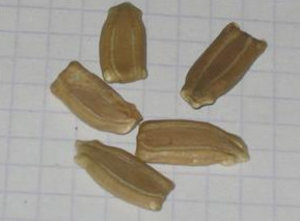 Seeds of it exotic vegetable quite dense, it is not easy for them to germinate in our conditions, so some gardeners recommend cutting off the top on the seed opposite to the one where the embryo is located. But not everyone decides on this. In most cases, they are limited to soaking seeds in solutions of special biological products. Depending on the recommendations of the drug manufacturer, this process can take from four hours to two days. Then the germination of lagenaria seeds is carried out in any humid environment. For example, in wet sawdust, where the seeds must lie for about six days at a temperature not lower than 23 ° C. At home, a conventional central heating battery is suitable for this. This guarantees 100% germination of planting material.
Seeds of it exotic vegetable quite dense, it is not easy for them to germinate in our conditions, so some gardeners recommend cutting off the top on the seed opposite to the one where the embryo is located. But not everyone decides on this. In most cases, they are limited to soaking seeds in solutions of special biological products. Depending on the recommendations of the drug manufacturer, this process can take from four hours to two days. Then the germination of lagenaria seeds is carried out in any humid environment. For example, in wet sawdust, where the seeds must lie for about six days at a temperature not lower than 23 ° C. At home, a conventional central heating battery is suitable for this. This guarantees 100% germination of planting material.
Planting lagenaria for seedlings
When the first shoots appear, they are sprayed once a week with a growth stimulator and watering is started as needed. Lighting should be as intense as possible. A week after the appearance of sprouts, sawdust can be lightly sprinkled with biohumus. And only after the appearance of the third leaf, germinated seeds can be transplanted into separate peat or paper cups.
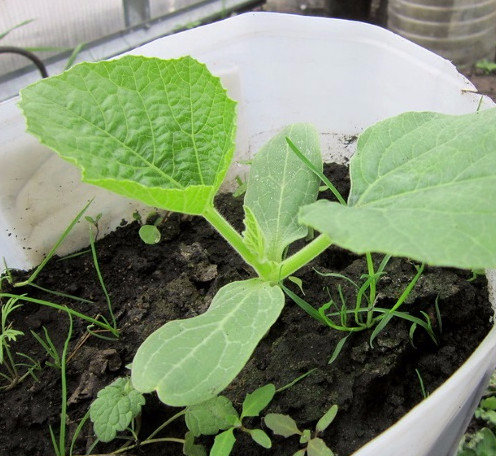 Sprouts are placed in a soil consisting of peat, humus and river sand. Some experts recommend adding a little wood ash to the mixture (0.5 kg of ash per 10 kg of the mixture). Seedlings of lagenaria, when planted with seeds, grow and grow stronger in individual containers from three to five weeks.
Sprouts are placed in a soil consisting of peat, humus and river sand. Some experts recommend adding a little wood ash to the mixture (0.5 kg of ash per 10 kg of the mixture). Seedlings of lagenaria, when planted with seeds, grow and grow stronger in individual containers from three to five weeks.
seedling care
Seedlings should be in a well-lit room at a temperature of about 15 ° C. Caring for her is simple: watering as needed and periodic airing are necessary.
When and how to plant seedlings in open ground
If the seeds were sown in mid-April, then by mid-May they are ready for planting in open ground. It is important that at least 30 days pass from the moment of sowing, the seedlings have a growth of at least 10 cm, and there is no longer a threat of frost on the ground.
Holes are dug in the ground about 25 cm in diameter at a distance of about a meter from each other. In each of them you need to add a handful of complex fertilizer and two handfuls of sawdust, ash, two tablespoons of superphosphate. Seedlings from cups are placed in the hole carefully so as not to damage the root system. From above, the soil is recommended to be mulched with leaves or sawdust. Knowing what kind of plant lagenaria is, it is recommended to carry out mulching in two layers: the usual material for shelter and a film pressed down with stones. This helps to raise the temperature at the roots of the plant, which is extremely thermophilic.
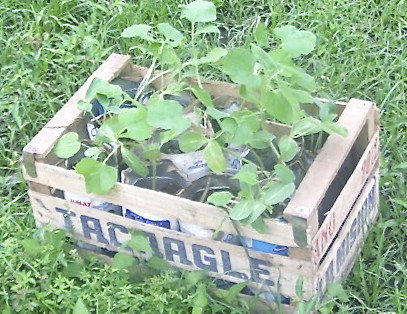 It is recommended to install a protective film on top of the seedlings. It is pulled over the crossbar, fixed at a height of 70 cm in the center of the bed. Its edges should extend beyond the film that covers the ground. When it gets warmer outside, the top shelter is slightly opened. It is finally removed when stable warm weather is established. As a rule, at this time the plant begins to bloom and is already long enough to be installed on a trellis.
It is recommended to install a protective film on top of the seedlings. It is pulled over the crossbar, fixed at a height of 70 cm in the center of the bed. Its edges should extend beyond the film that covers the ground. When it gets warmer outside, the top shelter is slightly opened. It is finally removed when stable warm weather is established. As a rule, at this time the plant begins to bloom and is already long enough to be installed on a trellis.
Features of caring for lagenaria in the open field
Lagenaria does not require complex methods of cultivation and care. She needs proper watering, fertilizing and spraying. The latter is carried out approximately once every two to three weeks with special preparations, for example, "Ovary".
Watering and feeding lagenaria
These measures for caring for a vegetable are no different from the rules for caring for a pumpkin. . You can feed lagenaria with mullein twice a summer and three times with potassium sulfate at the rate of a tablespoon per bucket of water. To improve the taste of vegetables, you can add Magbor fertilizer once a season in the same proportion. When the fruits are poured, two handfuls of ash can be poured under each bush.
Important! The bottle gourd blooms in the evening and blooms at night, so its cultivation requires hand pollination. To do this, take pollen from male flowers, which are on the illuminated branches during the day, since pollen in flowers growing in the shade is sterile. It is also unsuitable if water gets into the flower.
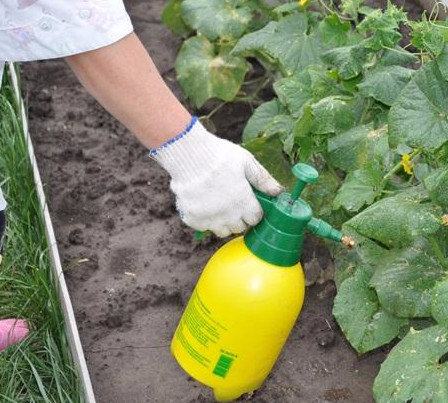 There are other schemes for plant nutrition. For example, once a week during the entire growing season, give the drug "New Ideal" at the rate of a cap of liquid per liter of water. Spray alternately with Silk and Epic growth stimulants several times a season. When the plant begins to bear fruit, it is recommended to give foliar top dressing with the “Two Harvest” remedy.
There are other schemes for plant nutrition. For example, once a week during the entire growing season, give the drug "New Ideal" at the rate of a cap of liquid per liter of water. Spray alternately with Silk and Epic growth stimulants several times a season. When the plant begins to bear fruit, it is recommended to give foliar top dressing with the “Two Harvest” remedy.
The scheme of watering the plant is the same as for the pumpkin. Basically, it is recommended to water it as needed, preventing the soil from drying out, but not flooding it. But there is an opinion that it is better not to add lagenaria than to pour it, otherwise the risk of diseases increases and the taste of the fruit worsens. When watering, make sure that water does not fall on the root neck of the plant. If this happens, it must be sprinkled with ashes. You only need to water the plant warm water. By the end of August, watering is stopped so that the fruits can ripen well.
The question of how to properly grow lagenaria rests on the need to install a support for the plant: the culture is curly, long, and its fruits are large and heavy. To do this, it is necessary to install a trellis-ladder with a height of at least two meters on the garden bed, on which, as it grows, tie the fruits and lashes of the plant. But you can plant lagenaria in advance against a wall, fence or fence and put shoots on them as decoration. 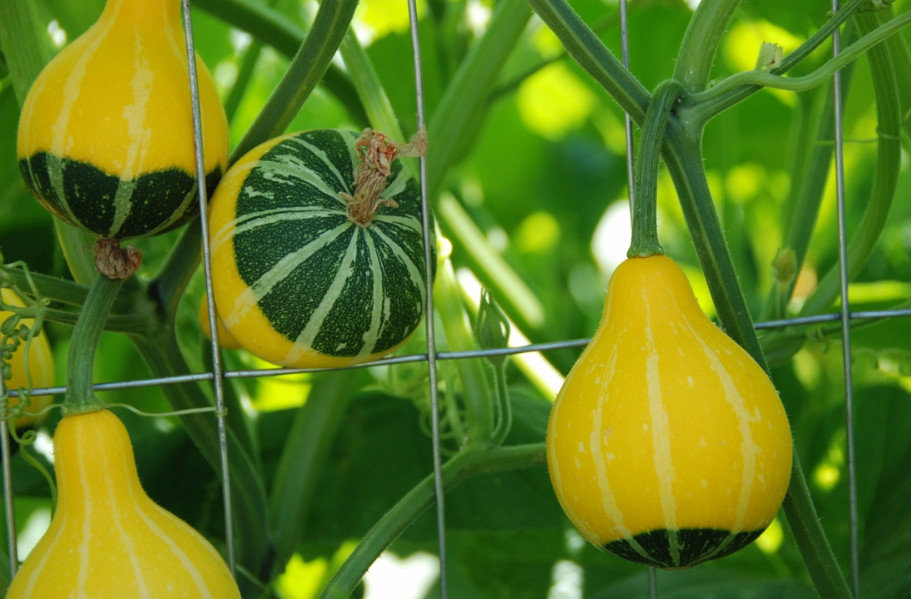 It is necessary to tie the whips on the trellis every meter of the shoot. If lagenaria grows against a wall or fence, shoots must be directed upwards so that its antennae have the opportunity to attach in the right direction.
It is necessary to tie the whips on the trellis every meter of the shoot. If lagenaria grows against a wall or fence, shoots must be directed upwards so that its antennae have the opportunity to attach in the right direction.
Pinching and pruning the plant
Lagenaria is a plant that, in addition to special planting and care rules, requires timely pinching and pruning. This helps stimulate the growth of side branches and limit the growth of the main shoot. Otherwise, it can stretch up to 15 meters. Even side shoots can reach 10 m in length. Considering that the height of the trellis usually does not exceed two meters, the whip has to be directed either up or down.
Important! In whatever direction the growth of the shoot is directed, its top should always be in the sun. They begin to pinch the shoots when their length reaches three meters. Such events stimulate the appearance of female inflorescences, on which fruits are formed.
Features of harvesting bottle gourd
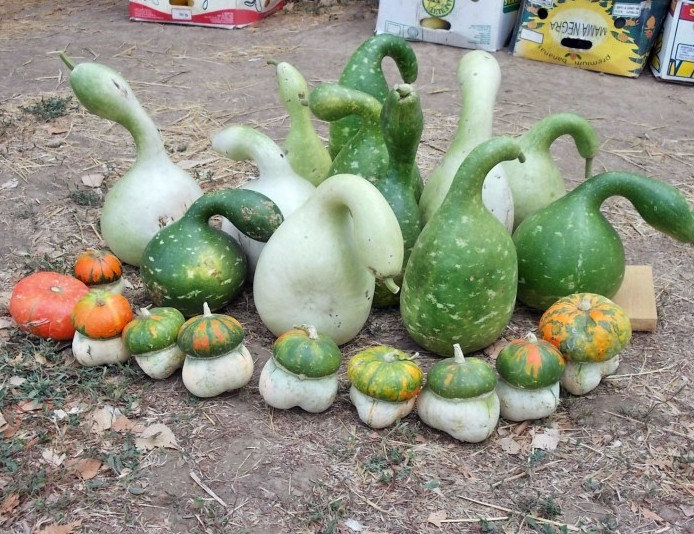 Vegetables are highly productive. Up to 60 kg of fruit can be harvested from one bush, and even more in especially fruitful years. Remember, if you plan to eat them, you need to remove unripe vegetables.
Vegetables are highly productive. Up to 60 kg of fruit can be harvested from one bush, and even more in especially fruitful years. Remember, if you plan to eat them, you need to remove unripe vegetables.
If you plan to harvest seeds, you can leave the crop until autumn, but remove it without waiting for frost, otherwise it will not be stored for a long time. It is better to remove the unripe vegetable with part of the shoot and leave it at the central heating battery. So he will be able to ripen after some time, and by December it will dry out, leaving intact seeds inside. After that, the vegetable can be opened and removed. They retain their viability for up to 10 years. Did you know? To enjoy the harvest, it is not necessary to remove the whole lagenaria fruit. Can be cut from a ripe vegetable required amount. The only condition: this must be done in dry weather, and the cut can be covered activated carbon. Then it will drag on, no infection will get into it, and a cork-like crust will form at the cut site. The vegetable will continue to pour further. The unique lagenaria plant is interesting not only as a vegetable crop. It tastes like vegetables of the gourd family. But the fruits have such an original shape that the plant is also grown for decorative purposes, including as a decoration for hedges, walls and trees. When ripe, they are used as a basis for the manufacture of various household items. At the same time, caring for the plant is simple. It is important to provide him with enough light and heat.
Was this article helpful?
Not really
There are many varieties of pumpkins that can decorate any.
But among the decorative species, a special place is occupied by a bottle gourd - lagenaria, which is a rather long vine with unusual pear-shaped fruits resembling the shape of nesting dolls.
The bottle gourd, which is not difficult to grow, is truly exotic.
The bottle gourd belongs to a separate genus in the Cucurbitaceae family, which is called Lagenaria. This means that she is a cousin to common pumpkins, cucumbers, melons and watermelons. There is an opinion that it was brought from Africa and then became widespread in Europe. In ancient Rome, not only various dishes were made from it, but wine barrels were made from large specimens.
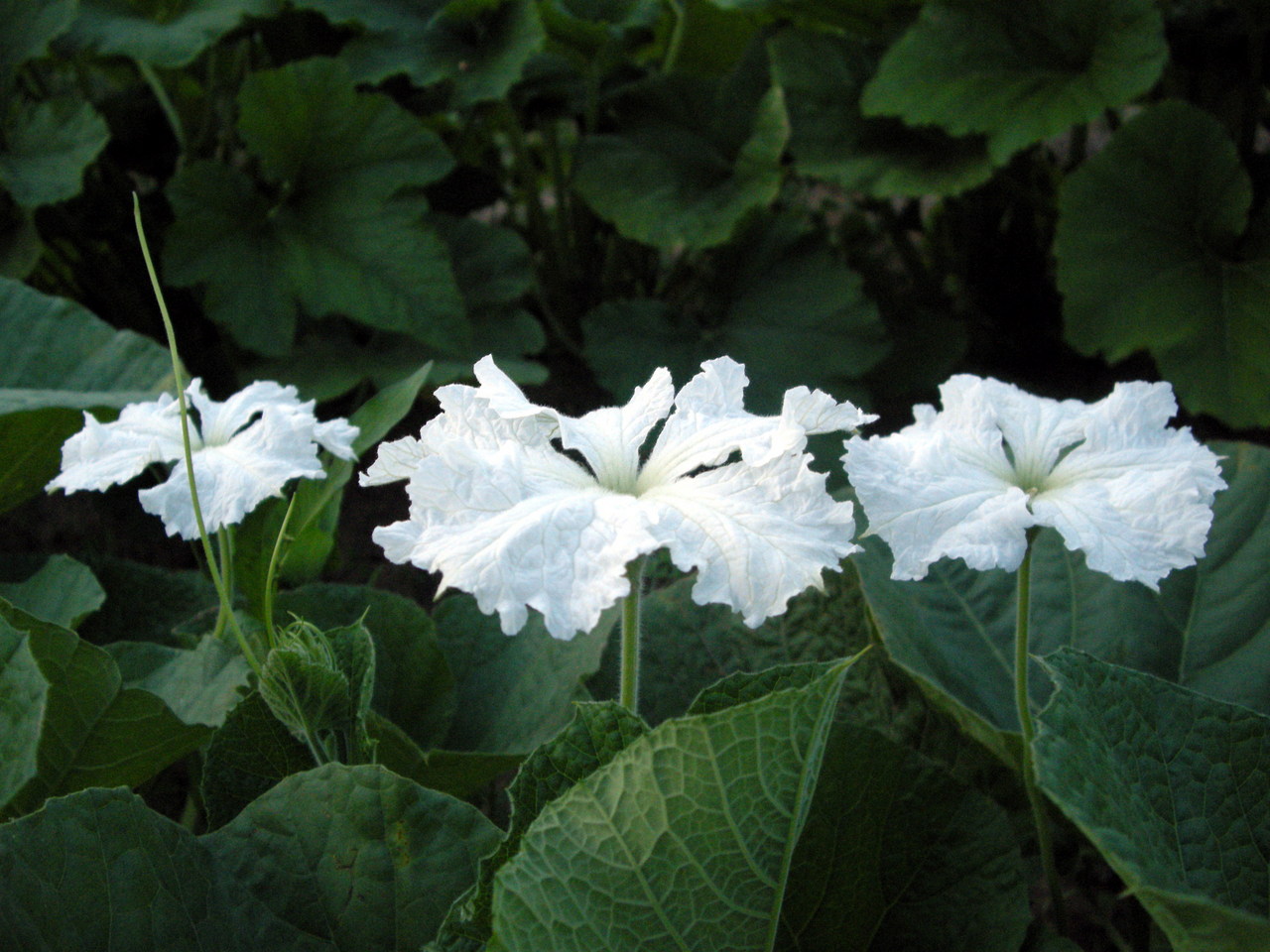
An annual plant with beautiful corrugated foliage and pleasantly smelling white - yellow flowers.
Interestingly, flowering can only be seen at night, when this gourd is in bloom.
The stem of lagenaria, like almost all gourds, is of the liana type.
A characteristic feature is its faceted, fluffy and rather large length, sometimes reaching 15 meters.
Large fruits are quite light, especially when dried. They can take a round shape, pear-shaped, and in general there is a variety of shapes. On one plant grows up to 15 fruits weighing up to one and a half, or even two kilograms, reaching up to 0.5 m in length and at least ten centimeters in diameter. In some varieties of bottle gourd, fruits reach 2 m in length and up to 8 kg in weight.
There are about seven types of bottle gourd, the description of which is almost impossible due to the large number and variety of forms. Therefore, we will focus on the most common form - the ordinary one, which has received the widest distribution in gardens and household plots of the Russian Federation.
Most species of lagenaria are unsuitable and even harmful for human consumption. Some have a taste reminiscent of ordinary, but with a spicy aftertaste. And some varieties are bitter in taste, and the pulp resembles cotton wool. Such a pumpkin is not suitable for food, and its juice can become a real poison for the body.
Growing lagenaria seeds
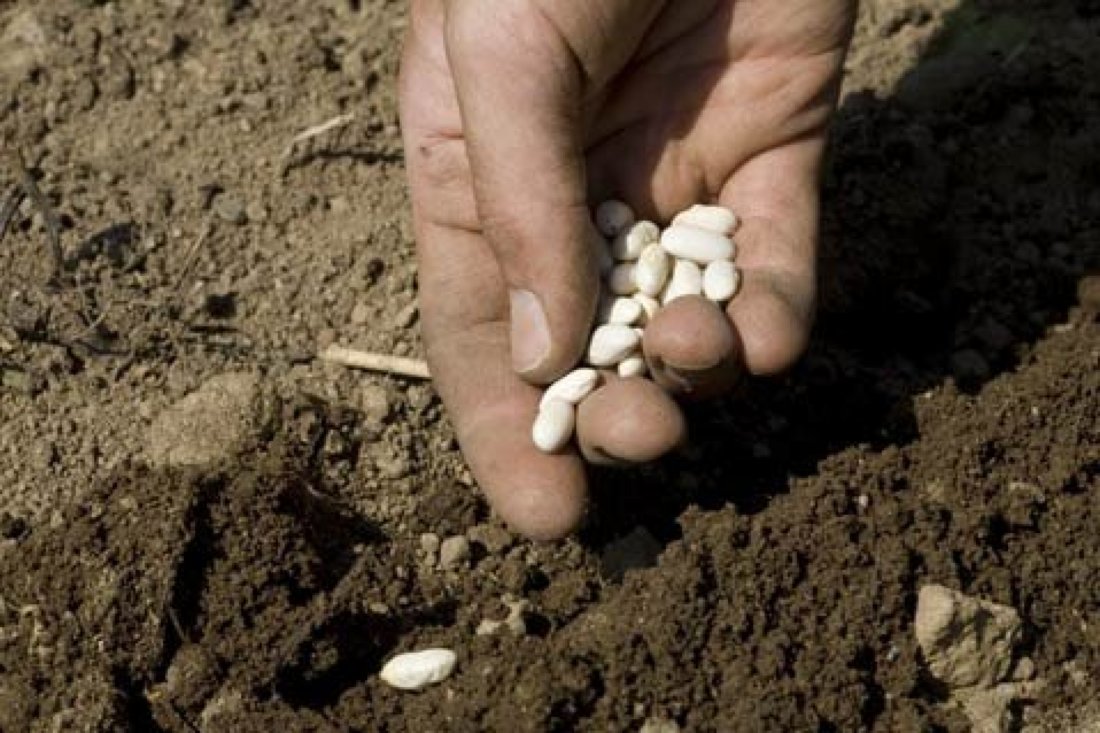
Having decided to grow bottle gourd from seeds, you need to know that fresh (harvested from last year's harvest) seeds may not bear fruit due to the fact that in gourds from such seeds the plant can only produce male flowers.
Therefore, if you decide to grow your own seeds, then it is better to use seeds of 2-4 years of collection for this purpose.
To sow seeds, own or purchased, they must undergo some training.
This is done for guaranteed germination and quality:
- Soak. An envelope is made from a rag in which seeds are placed. Then this rag is watered with a small amount (so that it is damp, not wet) of warm water. Can be added to water for better germination a small amount of growth stimulant.
- After the seed swells, which usually occurs on the fourth day, the seed shell should be split and the seeds should be put back into the envelope. Don't forget to keep it moist.
- When sprouts appear on the seeds, they can be planted in separate growing cups.
In regions with a hot climate, seeds are usually planted directly into the ground, after primary processing.
Features of growing seedlings
It is better, of course, to grow such exotics everywhere through seedlings. It is not known how long summer can be this year in the southern regions. And fruit maturity after germination occurs no earlier than three months later. Only fully ripened fruits have a strong rind and are capable of long-term storage. Unripe ones will not be suitable for crafts and will quickly rot.
First you need to calculate the time from sowing the seeds to planting in. Focusing on the middle zone of our country, seeds should be sown no earlier than mid-April. Germinated seeds are planted in a separate cup for each seed to a depth of about 1.5 cm.
It is better to use purchased soil for growing seedlings, as it contains all the nutrients and trace elements necessary for plant growth.
After planting, you should monitor the soil moisture and prevent it from drying out and waterlogging. After about 30 days and the appearance of four true leaves, the seedlings should be transplanted into open ground.
Subtleties of cultivation and care
Under the conditions created for the bottle gourd and proper care, it grows quite quickly.
Conditions
The soil on which you are going to grow lagenaria should be rich in organic fertilizers, have a well-drained structure and should be neutral in terms of pH. Cucurbitaceae do not respond well to acidic soils, and in alkaline soils they develop slowly and incompletely.
Landing is best done on the south side next to a fence or some kind of wall. The plant grows very strongly and it needs support for the growth of the vine.
Care
- Seedlings should be planted at a distance of at least a meter from each other. Water only as needed cold water and don't over-moisturize.
- With properly prepared soil, fertilizing is usually not necessary. But if the plant does not gain color well or slows down in growth, then you can fertilize with manure or infusion of herbs.
- When the creeper reaches two meters in length, it is better to pinch the stem and side shoots. For a more complete development of the fruit, part of the ovaries should be removed without creating competition. With insufficient formation of ovaries, it is recommended to pollinate female flowers with male flowers manually.
- Lagenaria blooms flowers from the late evening, and closes them in the morning. In addition to beautiful flowering, they also emit a very pleasant smell.
- Fully ripening of exotic pumpkin fruits occurs in September - October. You need to remove them from the vine with the stalk as they ripen. If you decide to dry the fruits, then it is better to leave them on the whip or dry them in the fresh air. A fully ripened fruit, which has formed a hard peel, is not afraid of frost and autumn rains.
The bottle gourd is multi-resistant. But under certain weather conditions and the growing region, it can get sick with cucumber mosaic, anthracnose or powdery mildew. If you notice the appearance of the disease, then when growing the next year, preventive spraying of seedlings and plants with preparations is necessary. It is better to use the biological product Fitosporin-M for this purpose.
Use for grafting
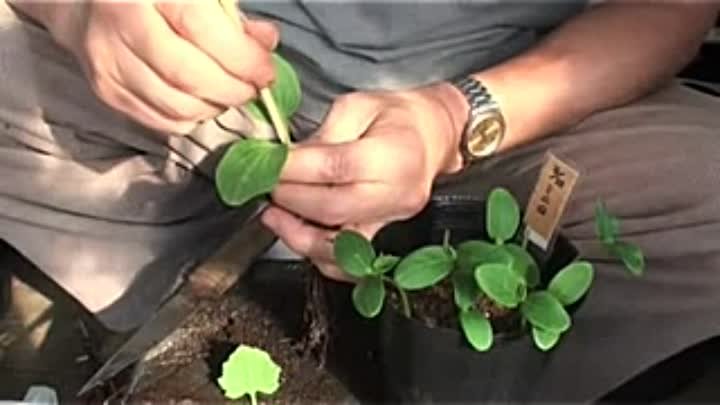
Bottle gourd, due to its powerful root system, rapid growth and disease resistance, is successfully used by gardeners to graft pumpkin family crops to it.
Its close relatives, such as cucumbers, watermelons and melons, supported by the grafting of such an easy-care plant, begin to bear fruit earlier and more abundantly.
How this is done can be considered using the example of grafting a cucumber:
- Cucumber seed is sown in a glass. Due to the rapid growth, the pumpkin seed is planted three days later, but in a different container. After about a week, the plants reach almost the same height and have a stem thickness of 0.5 cm.
- A separate container is being prepared, which should include seedlings of pumpkin and cucumber. poured right amount soil and both plants are transferred to a new container, placing them closer to each other. It is important to place them so that they are on the same level.
- In lagenaria pinch the point of growth.
- Using a blade, carefully cut the stem of the pumpkin from the top down one centimeter and half in depth. The same manipulation is performed with a cucumber. Only the cut goes from bottom to top.
- The tongues of both cultures are inserted into each other and fixed with a special clip or just tape. Then they are shed with warm water, shaded for a while. After a few hours they are placed in the sun.
- A week later, the cucumber stem just below the graft is removed, and a week later it is cut off completely.
If you did everything right and the plants took root to each other, then the grafted cucumber begins to grow rapidly and bears fruit much earlier. The main thing is that he has a powerful root system and is resistant to.
Applications
The fruits can be harvested young for eating, or well-ripened and dried can be used for all kinds of crafts. On the same plant, fruits can have a variety of shapes. To give the necessary shape, the fruit is placed in a wooden structure of the desired configuration.
What can be made from bottle gourd fruits:
- Amazing dishes, caskets, ashtrays, etc. Well-dried bark is well painted and varnished. On it you can burn various patterns and inscriptions.
- Smoking pipes.
- Folk musical instruments.
- Children's toys, etc.
Moreover:
- The ripened and dried fruit has a strong wooden shell. Containers made from lagenaria store fresh water for a long time and long time keep her cool.
- Young fruits are used in cooking. From them you can make salads, stew, fry or preserve. For example, pickled thin sticks of this type of pumpkin are very popular in Japan.
- From young fruits it turns out very tasty. pumpkin caviar, and bottle gourd seeds are valued for making edible oil.
- This type of gourd has found wide use in traditional medicine. The pulp contains a high content of ascorbic and nicotinic acids. Not a small content of vitamins B and E. Contains carotene, mineral salts, sugar, etc.
- It is successfully used in folk medicine for the treatment of cardiovascular diseases, liver and kidney diseases, bladder and stomach problems. And due to its dietary component, lagenaria is used as a product for weight loss.
- In most cases, medicinal ointments are prepared from it and infusions are made. But also a very effective effect of prepared lotions.
- The use of bottle gourd seeds can rid the body of worms. And recent research in the field of oncology gives hope that the healing qualities of pumpkin can stop the development of certain types of cancerous tumors.
- Being a natural antioxidant, the use of lagenaria helps to increase immunity and protective functions in the fight against infection and viruses.
But still, the main purpose of such an exotic pumpkin is to use it for crafts. And even a beginner can grow such a plant. The main thing is to find a suitable place for this size vine.
How to make souvenirs from lagenaria - you can watch the video:
Noticed an error? Select it and click Ctrl+Enter to let us know.
Hu Lu gourd(other names are lagenaria vulgaris, calabash) is one of the most famous health charms in Feng Shui. The gourd is shaped like a figure eight (for the Chinese, 8 is a symbol of constant and growing prosperity, good luck and success) and an inverted infinity (an endless, never-ending stream of abundance), which symbolizes the power of this talisman.
Pumpkin gourd Hu Lu: what is it for and where to put it
It is believed that the gourd accumulates negative energy in itself and does not allow it to break out. That is why the Chinese advise putting this talisman at the head of the bed of a sick person. They believe that the pumpkin takes away the bad energy of illness and helps the person to recover.
In addition, with the help of gourd gourd, you can successfully deal with negative influence the flying star of disease (Black 2) and the star of misfortune (Yellow 5).
!!! In 2017, in order to weaken the influence of the Black Two, it is recommended to bet on northwest premises a gourd or other talismans of health and longevity (lucky bamboo, crane, turtle, god of longevity Sau, etc.).
!!! Also in 2017, it is useful to have a health talisman on south to protect against the influence of the imperial star - the Yellow Five.
Pumpkin gourd Hu Lu can not only help recovery or protect against diseases.
With the help of this wonderful talisman, you can improve family relationships − between spouses, children or other relatives. It is enough to place the gourd in the right sector: in the zone of love and marriage or in the bedroom - if you want to improve relations with your partner; to the zone of children and creativity or nursery - if you want to see a good relationship between your children; to the family sector or living room (can be in the dining room) - if you want to be in excellent relationships with relatives, friends or other people.
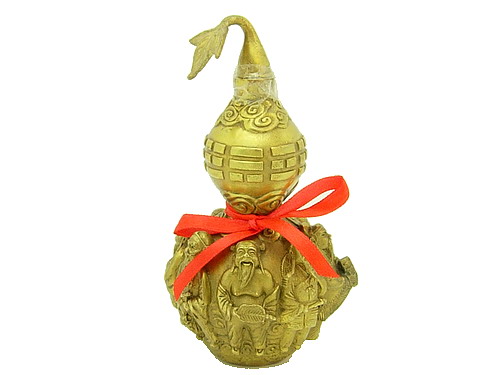
In addition, the talisman can be placed in the office or on the desktop. He will help it is better work or study , because, just like in other cases, it will collect negative energy in itself and contribute to working capacity.
Pumpkin Hu Lu: other aspects
The gourd talisman can be made from different materials, and any drawings or hieroglyphs can be depicted on the pumpkin. If a dragon is depicted on a gourd, then it is believed that the effect of the talisman is enhanced.
The talisman can be tied with a red ribbon - this is done to activate it. If there is no red ribbon initially, then you can tie up the pumpkin yourself with red ribbon or thread.
Pumpkins are made with or without a lid. If your pumpkin has a lid, then you need to keep it open - this way the negative energy will flow into the pumpkin. However, if the pumpkin does not have a lid, this is not critical and such a pumpkin can also be used.
To cleanse the gourd of negative energy, rinse it with running water, and then rinse it with salt water (salt is an excellent absorbent of negative energy). After a day, the talisman can be used again.
Good to you!
Few gardeners in our country know about the amazing plant - lagenaria, and in vain. Vietnamese zucchini, Indian cucumber, serpentine lagenaria - all these are the names of one unique plant from the pumpkin family, which has been known to people since ancient times. In ancient China, it was even considered the king of all vegetables. A variety of vessels were made from lagenaria grown at the imperial court. It was considered a great honor to receive such a craft from the hands of the Chinese emperor.
And in the countries of tropical Africa and Asia from this original vegetable and to this day make ladles, bowls, mugs etc. In such a vessel, the water remains cool for a long time, and the milk does not turn sour. This is due to the fact that the peel of this pumpkin does not allow heat to pass through and is practically not exposed to microorganisms.
How to use lagenaria
After reviewing various photos lagenaria, you can see that this plant is a climbing herbaceous vine, but each variety has its own fruit shape. The most common are bottle gourds, so named due to the fact that their appearance is somewhat reminiscent of a bottle or vase.
You can use the plant in different ways:
- To eat.
- Decorate the site.
- Make unusual souvenirs and crafts.
- Use as rootstock for other cucurbits.
The fruits of lagenaria taste good and have dietary qualities that will be appreciated by everyone who cares about their health. Young fruits are eaten like cucumbers familiar to everyone, but best dish from lagenaria it is caviar. It is prepared according to the same recipe as zucchini, but it turns out to be much tastier. And this pumpkin can be pickled, canned, and even the leaves and young stems are good for food. This plant has one unusual feature. Its fruits can be cut not completely, but in parts. He wanted to eat - he cut off half a pumpkin. The remaining half will not rot, but will heal and continue to grow.
The optimal length of the fruit is about 50 cm. During this period, their flesh is tender, and the peel is thin. But the longer the vegetable grows and ripens, the more the tissues dry out, and the peel hardens and gradually turns into a real shell. So ripe fruits are used only for the manufacture of various souvenirs, they cannot be eaten.
Dishes from lagenaria are very useful for the body, because they contain magnesium, calcium, iron, vitamins B 1, B 2, C, PP. It is recommended to use it for diseases of the stomach, of cardio-vascular system, liver, bladder and kidneys. This amazing plant helps to improve metabolism, remove cholesterol from the body and even slow down the growth of tumors.
 Bottle lagenaria is grown not only for the sake of fruits. This mighty tropical liana is very beautiful and can be used for decoration. Her leaves are large, velvety to the touch, with long petioles. The flowers are goblet-shaped and quite large. But the most interesting thing is their color: a light cream in the morning, the flower turns into almost white in the evening.
Bottle lagenaria is grown not only for the sake of fruits. This mighty tropical liana is very beautiful and can be used for decoration. Her leaves are large, velvety to the touch, with long petioles. The flowers are goblet-shaped and quite large. But the most interesting thing is their color: a light cream in the morning, the flower turns into almost white in the evening.
Unfortunately, they fade quickly, but in place of the fallen ones, new ones immediately appear, so the lagenaria will decorate your yard with abundant flowering until late autumn. The fruits can also be shaped to your liking by placing the ovaries in different wooden molds. The pumpkin will grow and take the form you want.
The root system of lagenaria is very powerful. She is fast builds aerial and underground roots. The main root is thick and has a length of more than 80 cm, and the lateral ones are 3 m or more. For this reason, the vine is often used as a rootstock when growing valuable varieties of pumpkin, watermelon or melon.
Lagenaria is a native of the warm tropics, and for this reason it is very demanding on moisture, lighting and temperature. It is best to plant the plant in the sunniest place, reliably protected from cold winds, because even light frosts will cause irreparable harm to it. The soil should be fertile, structural, well fertilized with humus. But it is better not to plant a vegetable in acidic soil, he does not like this. The proximity of groundwater will also have a bad effect on the growth of lagenaria.
You need to prepare the perfect garden bed for a tropical guest in the fall. For this, per 1 m 2 of land contribute:
- 1 tablespoon potassium sulfate;
- 0.5 cups of ash;
- 2 buckets of manure;
- 2 tablespoons of superphosphate.
The bed, after making the addition, must be deeply and carefully dug up.
How to prepare seedlings
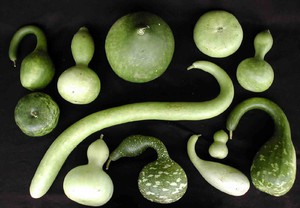 The seeds of lagenaria are brown or light brown, quite large and have the shape of an irregular rectangle. Their peel is very hard, so before sowing they need to be soaked for half an hour in hot water and then germinate for 2-3 days in wet sawdust or wet cloth. Some gardeners, in order to significantly speed up seed germination, file the skin of the upper part of the seed with a file, but this must be done very, very carefully.
The seeds of lagenaria are brown or light brown, quite large and have the shape of an irregular rectangle. Their peel is very hard, so before sowing they need to be soaked for half an hour in hot water and then germinate for 2-3 days in wet sawdust or wet cloth. Some gardeners, in order to significantly speed up seed germination, file the skin of the upper part of the seed with a file, but this must be done very, very carefully.
When the seeds hatch, they are planted in individual containers or nutrient cups, with a volume of about 1 liter, filled with river sand and peat mixture in a ratio of 1: 2. 2 seeds are planted in each container to a depth of approximately 2 cm. Then the future seedlings are covered with foil and hidden in a warm place. It is not recommended to plant seeds directly in open ground, since in our climate they most likely will not germinate.
With the right combination of moisture and temperature, after 10 days the plant should give the first shoots, and as soon as this happens, the film should be removed and all seedlings transferred on the sunniest window sill. The weakest plant from each container must be removed, but not pulled out of the ground, but carefully cut with scissors. Young seedlings should be watered regularly, using only warm water. But you should not fertilize, just as you should not keep seedlings in containers for more than 30 - 32 days, so that they do not outgrow and pamper.
Proper planting of seedlings in open ground
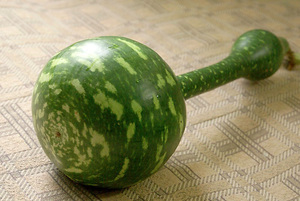 A few days before landing in open ground for lagenaria, it is time for hardening. To do this, the containers are taken out for a while Fresh air and open sun. When sowing seeds, it should be borne in mind that plants can be transplanted into open ground only when the soil warms up well and the threat of frost completely disappears, otherwise the lagenaria will die.
A few days before landing in open ground for lagenaria, it is time for hardening. To do this, the containers are taken out for a while Fresh air and open sun. When sowing seeds, it should be borne in mind that plants can be transplanted into open ground only when the soil warms up well and the threat of frost completely disappears, otherwise the lagenaria will die.
If the pumpkin sprouted in nutrient cups, then you can simply place them in small holes and lightly sprinkle with earth. But from ordinary containers, you need to get seedlings very carefully so as not to damage the sensitive root system. Lagenaria should be immersed in the ground to the cotyledon leaves, but if the seedlings have grown and reached a height of more than 25 cm, then almost the entire stem will have to be sprinkled with soil, leaving only the top on the surface. The earth near the holes must be firmly pressed with your hands, and mulch with rotted compost and humus. If it is still cool at night, the pumpkin should be covered with boxes or film. The ideal distance between plants is 1 m. This is quite enough for normal growth and development.
Lagenaria pumpkin does not have to be grown in a specially designated area. On the contrary, many gardeners place it near arbors and fences. Such a solution gives double benefit: firstly, you don’t have to make special supports for the liana, and secondly, this is how lagenaria decorates the site no worse than decorative climbing plants. You can plant it near an old tree, and let the whips go up.
Further care for lagenaria is easy. It perfectly tolerates heat and drought, however, the growth of fruits and shoots is reduced. To avoid this, it is recommended to water the plant at least three times a week, and preferably more often. For irrigation, only warm water is used.
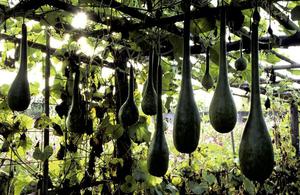 Flowers on the vine open only in the evening and are pollinated by nocturnal insects, but experienced gardeners advise not to rely on chance and pollinate the plant by hand. It's very simple. It is enough to collect pollen from a male flower with a brush or a cotton swab and transfer it to a female one. The procedure should be carried out in the morning or evening hours.
Flowers on the vine open only in the evening and are pollinated by nocturnal insects, but experienced gardeners advise not to rely on chance and pollinate the plant by hand. It's very simple. It is enough to collect pollen from a male flower with a brush or a cotton swab and transfer it to a female one. The procedure should be carried out in the morning or evening hours.
The resulting ovaries grow very quickly, and after two weeks they can already be eaten. If you want to get your own bottle lagenaria seeds, then the first ovaries should be postponed, and plucked just before the frost. They are kept in a warm room for a month, and in winter they cut the fruits with a hacksaw, remove the seeds, wash them, dry them and hide them in a dry place. Left to the mercy of fate, the fruits of lagenaria grow up to 2 m in length, and their weight often exceeds 7 kg 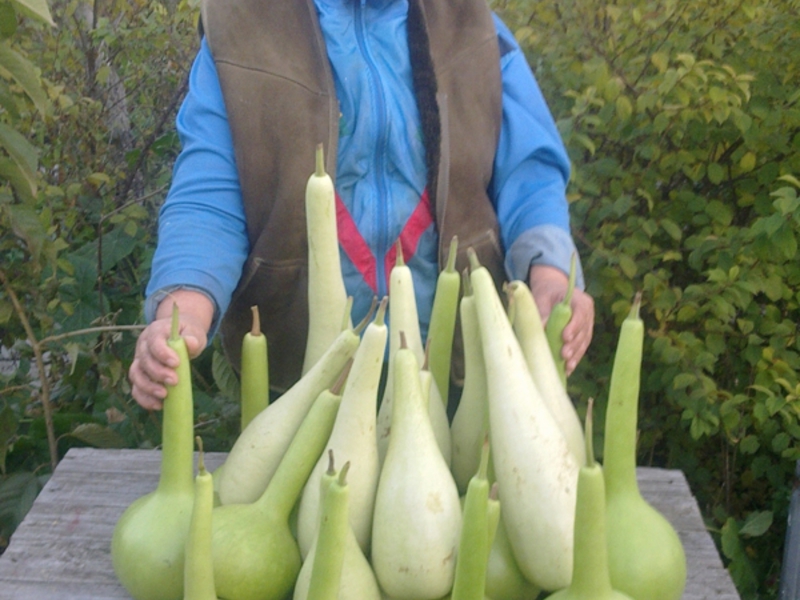
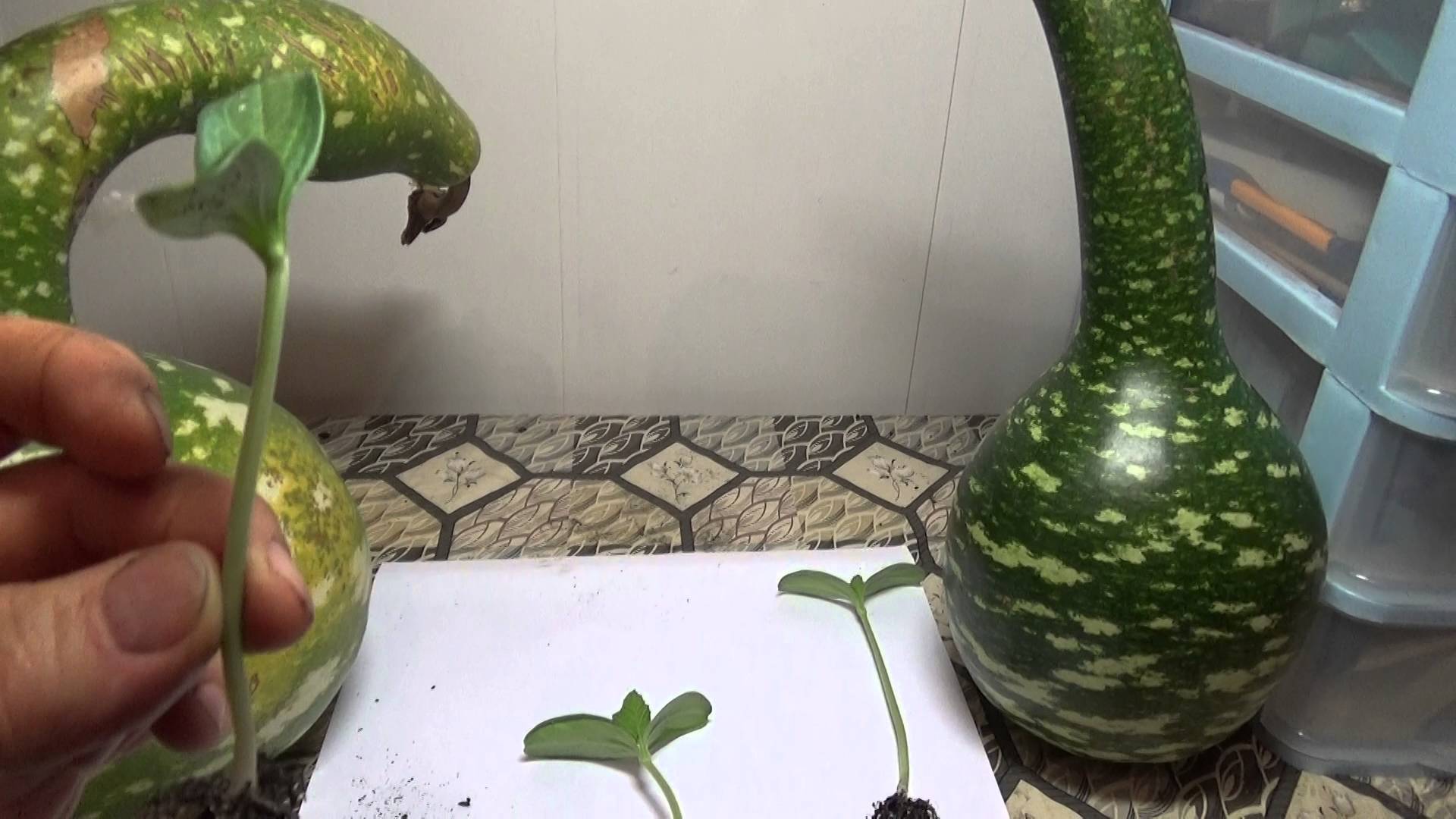
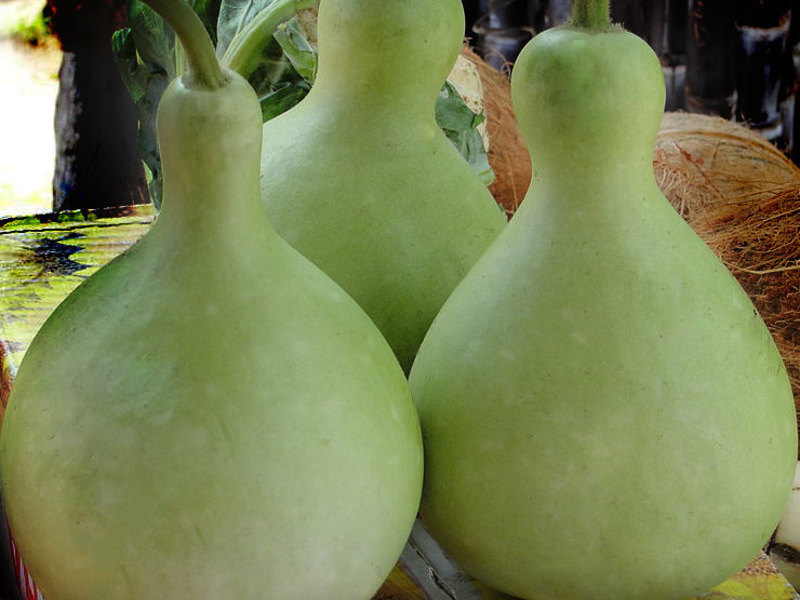
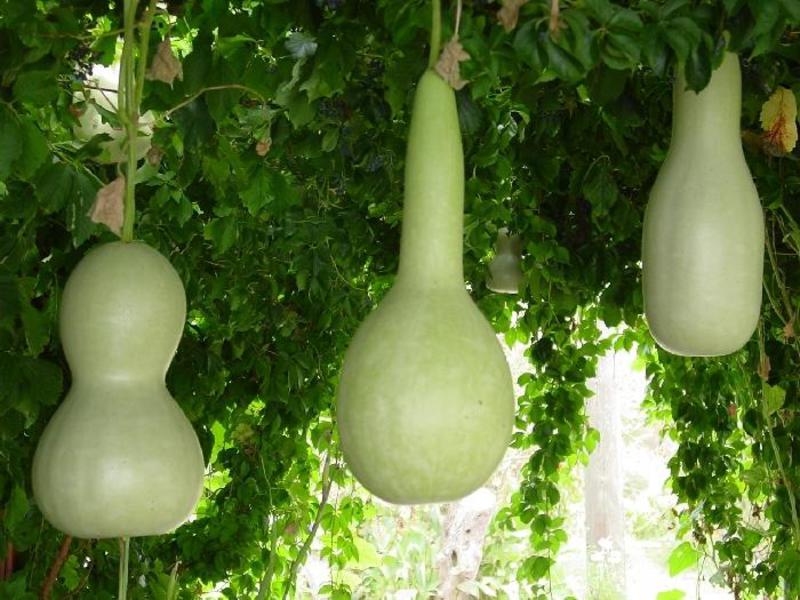
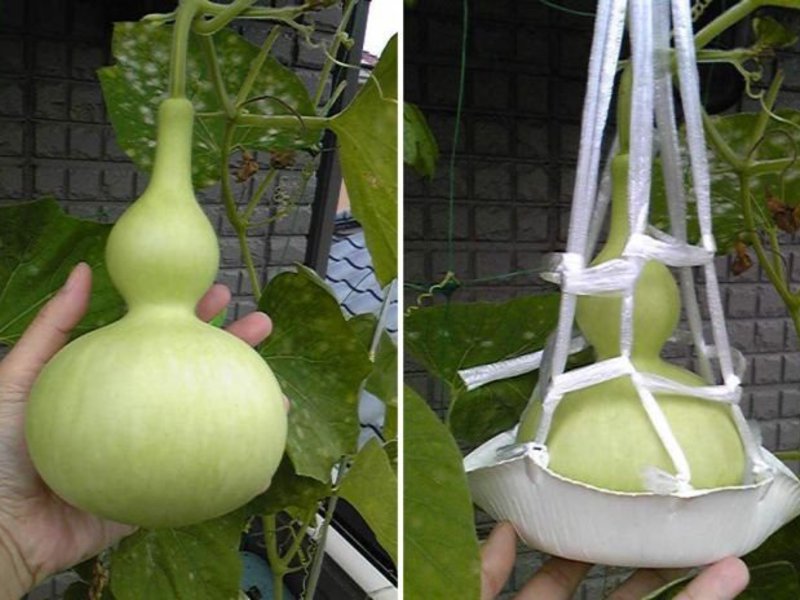
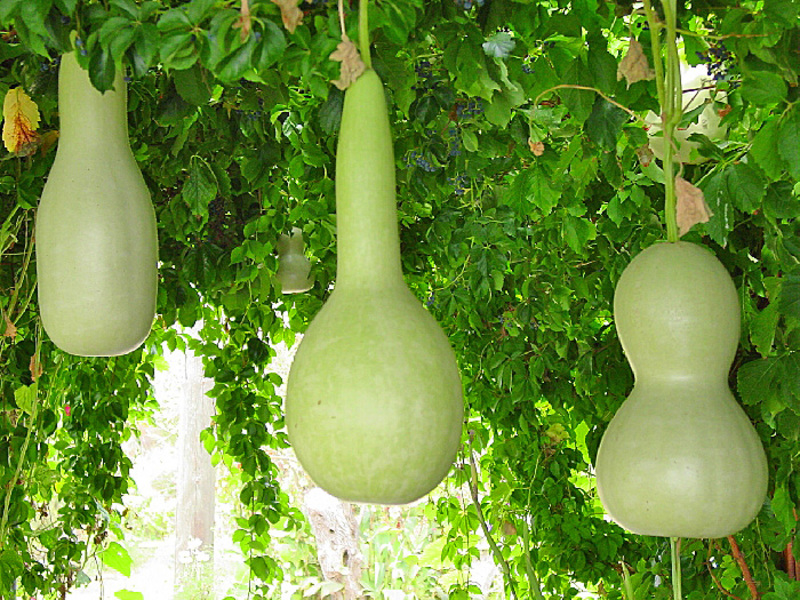
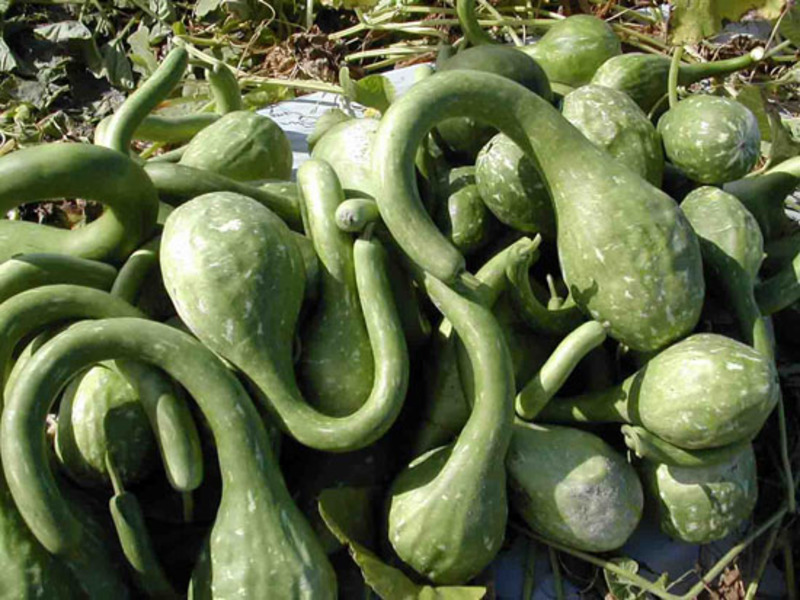
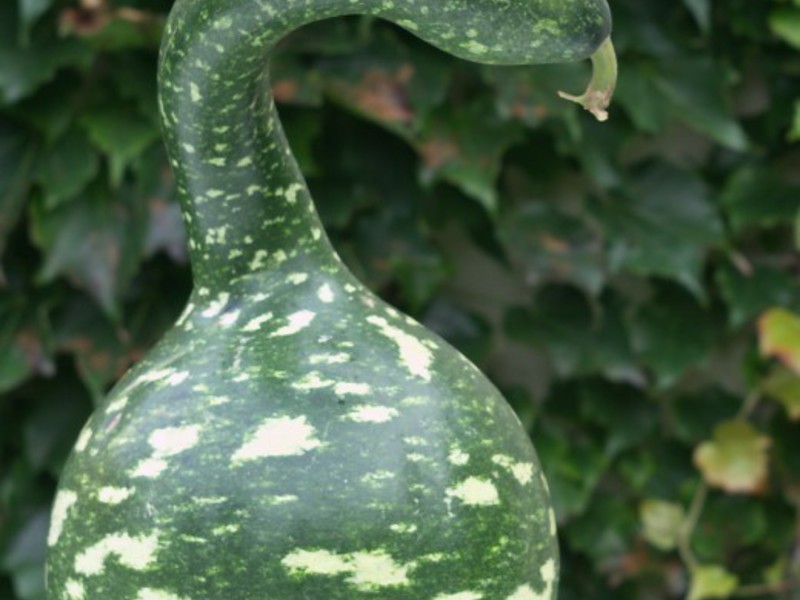
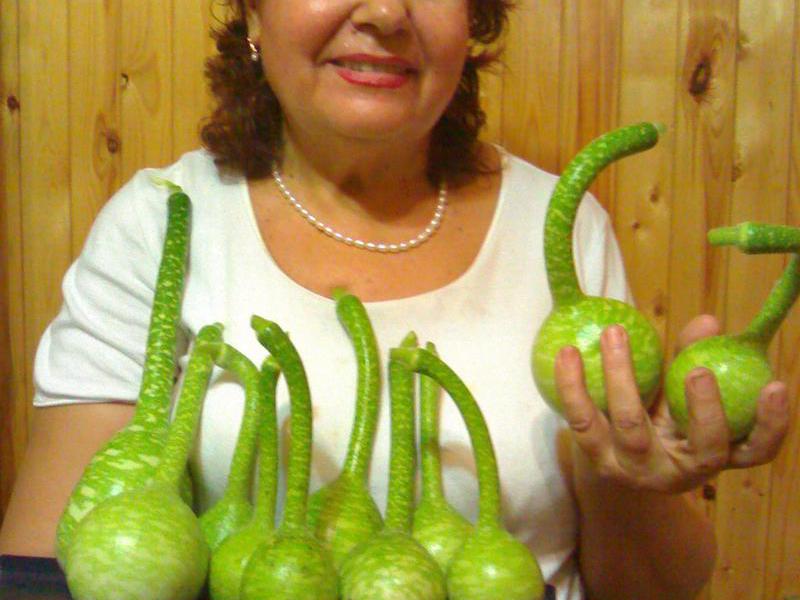
There are many varieties of pumpkin. When choosing which one to plant in your backyard, pay attention to such a variety of pumpkin as lagenaria, it is also gourd, bottle gourd, Indian cucumber or calabash.
Pumpkin is not only delicious vegetable but also very useful. She is a real storehouse of vitamins, carbohydrates and minerals. This plant is rich in fiber, thanks to which it has a beneficial effect on the functioning of the intestines. The fruits of the gourd have many others. useful properties: remove toxins, prevent sclerosis and obesity, and even inhibit the growth of tumors.
At the same time, only young, immature fruits of lagenaria are edible. When they ripen, they form a strong shell, completely unsuitable as food.
Interestingly, the fruits of this pumpkin are used not only for food. Feng shui talismans are made from gourds, and in the homeland of this plant, in Africa, ripened fruits are used as vessels for food and water, and even blanks for musical instruments.
Pumpkin gourd - cultivation
Gorlyanka refers to unpretentious varieties of pumpkin. It can be grown on almost any soil, except for waterlogged and those where the groundwater level is too high. He does not like this variety and strong winds, so lagenaria is usually planted along fences, houses or sheds. However, it does not require a separate bed, because this plant is well weaved and can be used as a compactor with legumes or potatoes.
To obtain good large fruits, it is recommended to fertilize a pumpkin of this variety with humus (before planting), mineral fertilizers (from autumn), and also during the season with bird droppings or.
The time and method of planting gourds, like other types of pumpkin, depends on the region. If in the southern regions the seeds can be planted directly in open ground at the end of May, then in the middle lane pumpkins are usually grown through seedlings. When planting, each hole should be fertilized with rotted manure, then put a layer of nutrient soil, plant seedlings and mulch the hole. This will prevent the soil from drying out quickly and save you from daily watering (you should know that the plant is very fond of regular watering with warm water).
Grow lagenaria bottle gourd 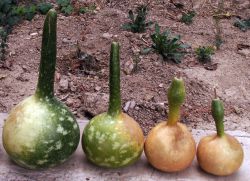 can be done both vertically and horizontally. In the first case, it is advisable to tie its long shoots to a support when they reach 1 m in length, and in the second case, a garter is not needed, but sheets of plywood or slate will have to be placed under the pumpkin fruits to prevent their damage. It is interesting that sometimes, in order to give the pumpkin a specific shape, it is placed inside a special wooden blank.
can be done both vertically and horizontally. In the first case, it is advisable to tie its long shoots to a support when they reach 1 m in length, and in the second case, a garter is not needed, but sheets of plywood or slate will have to be placed under the pumpkin fruits to prevent their damage. It is interesting that sometimes, in order to give the pumpkin a specific shape, it is placed inside a special wooden blank.
Also, do not forget about such moments of care as loosening, hilling (in the phase of 6 leaves), pinching the top of the main stem and removing extra ovaries (usually 3-5 fruits are left).


